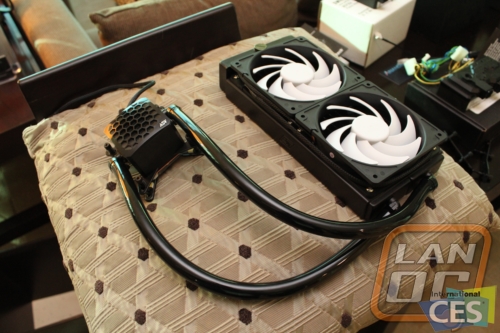
Written by: Adam
Pictures by: Wes
It was hard to ignore the table lined with identical towers as we were greet by Gabriel, who explained that they would be used for a live demonstration. No time was wasted as a sample of the new H220 was put in our hands, an all-in-one cooling configuration that shipped completed filled and assembled; ‘plug and play’, as Gabe referred to it. Compared to the previous H220 Elite kit, which retails for $239, the new H220 kit will MSRP for $139. That puts it in a much more affordable market, but of course we were curious on where that extra hundred dollars went.

The new kit is the exact same product except for the pump, which Swiftech has been buying OEM for years. Tired of waiting for a pump to develop that allowed them to bring the H220 into the market at the desired price point, an investment was made and Swiftech now manufacturers their own pump, which is a significant price savings. The target market also helped reduce the cost: with a larger demographic, resources could be purchased in a larger bulk, which brings down the overall cost of raw material.
There isn’t much difference between the two, just a few tweaks. “Because we entirely design and manufacture that pump, we specified the power, the consumption, the noise levels to our absolute own liking and specs. And our goal with this product was the embodiment for us for water cooling is performance at no noise. So we tuned that pump so that it would blend with the noise of the fans at high speed and would blend with the noise of the fans at low speed. And there is actually no noise at low speed because these fans run at 800 RPMs; low speed they’re practically silent. And the pump runs at 1200 RPMs at low speed, and its also practically silent. That’s why we advertise ‘from inaudible to quiet’. That’s the emphasis of this product.”


What this translates to is improvements not necessarily in performance, but in compatibility and convenience. A shorter unit, swivel tubes, smaller reservoir... and a few features tailored for novice users, such as placing the screw holes between fins instead of on the channel, to prevent any permanent damage if screws go too deep.


“Our aim for this product was to bridge the gap between the all-in-one novice user and the full custom do-it-yourself guys. And that is how, from back three years ago, how we started to envision the product, which is bridging that gap.”
The pump on the new H220 CPU cooler is 6 watts, a vast improvement on the old 1.2 watts, which breaks the barrier between solely a CPU cooler and the ability to push flow to multiple devices, when the time comes. To make expansion easier, the clamps are designed to to provide a tight seal but also survive the repeat installations that are sure to come with learning water cooling. Just tighten the clamp and make it flush with the flange, and you’re good to go. ”When you’re doing that, you’re clamping perfectly, and you know you have a good and tight seal. Small details, but details that count.”
The H220 sounds great on paper, and Gabriel came prepared for skepticism. He first talked about external testing. “We have certificates, we send twenty pumps to different labs, they run them for 45 days, they run them day and night, twenty-four hours a day. They have all the specs and all the components, and they try to crash that thing. Then they compile the report.” That report resulted in 60,000 hours estimated life, compared to 50,000 compared on previous units.
“Now let me put my money where my mouth is.” The test environment consisted of four completely identical systems, built with Maximus V motherboards and an overclocked i7 3770 housed inside a chassis known and recognized to be some of the best acoustics on the market. Not extremely high-end, but the purpose was to show thermals (and sound) at an equal load. The cooling solutions equipped were the only difference, comparing the Thermaltake Water 2.0, Corsair H100i, and the Swiftech H220. The fourth machine was also equipped with the H220, but was cooling also the chipset and two dedicated video cards in SLI.



The results were collected and displayed on an independent laptop, and were quite impressive. The image is a little hard to read, but to break it down:
Swiftech H220: Current 76.75C, Average 76.72C
Corsair H100i: Current 80.75C, Average 81.13C
Thermaltake Water 2.0: Current 79.50, Average 78.34C
Swiftech H220 + 2x GTX680 SLI: Current 81.25C, Average 82.04C

Not only did the H220 result in the coolest CPU cooling, but when adding the handicap of the 680’s was within two or so degrees of the competition cooling only the CPU. The last comparison was noise, which indeed was eye-opening. The H220 performed great in this test environment, needless to say we are excited to get our sample to put to the LanOC test.


